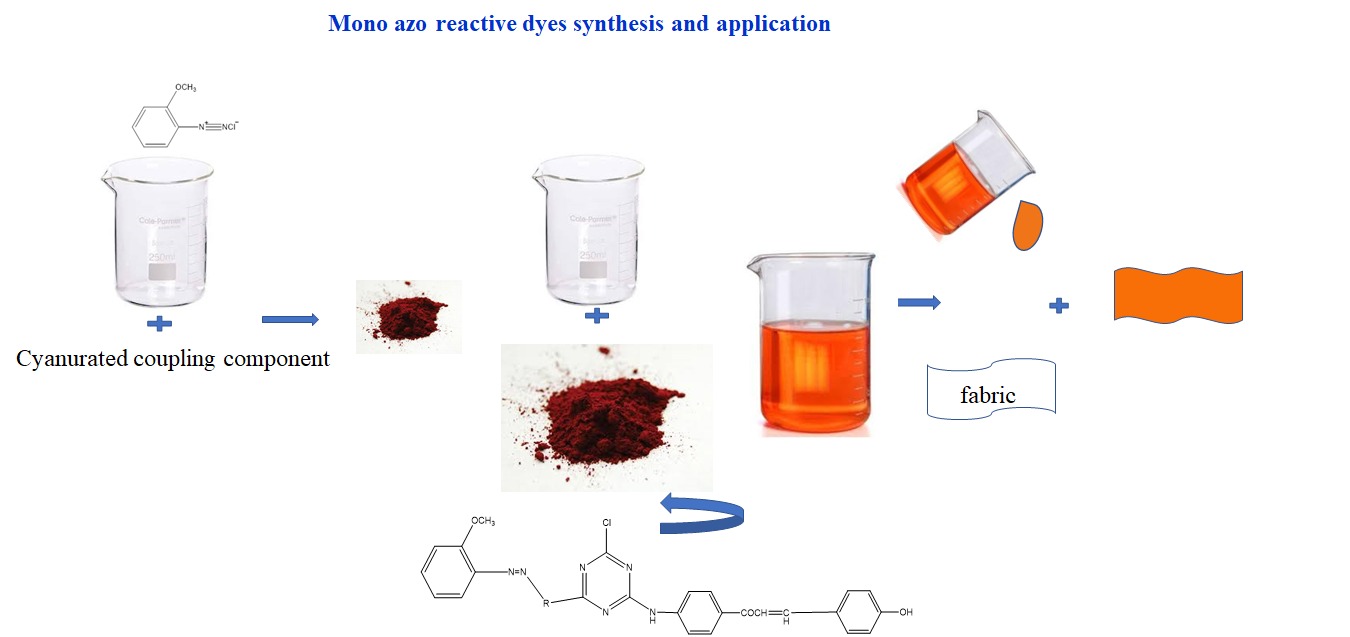Monoazo reactive dyes: Synthesis and application on cotton, silk and wool fibers
DOI:
https://doi.org/10.14295/bjs.v3i1.479Keywords:
synthesis, monoazo reactive dyes, application, cotton, silk, wool, fixation, fastnessAbstract
Mono azo reactive dyes are mostly used in textiles industries. The current study was developed to synthesize and apply mono azo reactive dyes. The primary goal of this research article is to highlight synthesized dyes with outstanding fixing properties for the dyeing and printing sectors to invent in future. Diazotized o-anisidine was coupled with several 4-amino-4ʼ-hydroxy benzilidene acetophenone cyanurated coupling component including H-acid, Gamma acid, J-acid, N-methyl J-acid, N-phenyl J-acid, K- acid and peri acid, to create a variety of monoazo reactive dyes. IR and elemental analyses were used to describe them. Moreover, the dyeing capabilities of each of these dyes on silk, wool, and cotton have been evaluated. The wet fastness properties also evaluated. Synthesized mono azo reactive dyes have excellent fixation values as well as fastness properties.
References
Hung, H-C., & Wu, C-G. (2021). Synthesis and kinetic study of a series of chloro- and m-carboxypyridium triazinyl reactive dyes. Dyes and Pigments, 188, 109147. https://doi.org/10.1016/j.dyepig.2021.109147 DOI: https://doi.org/10.1016/j.dyepig.2021.109147
Karacakaya, P., Kiliç, N. K., Duygu, E., & Dönmez, G. (2009). Stimulation of reactive dye removal by cyanobacteria in media containg triacontanol hormone. Journal of Hazardous Materials, 172(2-3), 1635-1639. https://doi.org/10.1016/j.jhazmat.2009.08.037 DOI: https://doi.org/10.1016/j.jhazmat.2009.08.037
Manoj, J. Patel, & Tandel, R. C. (2022). Dyeing and printing study of synthesized reactive dyes using phenyl urea bifunctional reactive dyes on cotton fabric. Materialstoday: Proceedings, 51(1), 770-778. https://doi.org/10.1016/j.matpr.2021.06.231 DOI: https://doi.org/10.1016/j.matpr.2021.06.231
Manoj, J. Patel, & Tandel, R. C. (2022). Application of reactive dyes by dyeing and printing method on cotton fabric and study of antibacterial activity. Egyptian Journal of Chemistry, 65(12), 101-110. https://doi.org/10.21608/ejchem.2022.101107.4697 DOI: https://doi.org/10.21608/ejchem.2022.101107.4697
Patel, D. R., & Patel K.C. (2010). Synthesis, characterization and application of quinazolinone based reactive dyes for various fibers. Fibers and Polymers, 11(4), 537-544. http://dx.doi.org/10.1007/s12221-010-0537-5 DOI: https://doi.org/10.1007/s12221-010-0537-5
Patel, A. B., Vashi, P. I., Patel, V. D., Patel, D. H., Patel, K. C., & Patel, P. S. (2019). Sythesis and application of monoazo reactive dyes on silk, wool and cotton fibers. Journal of Applicable Chemistry, 8(3), 1091-1098. http://www.joac.info/ContentPaper/2019/23-8-3-24-12.pdf
Patel, M. J., Tandel, R. C., Sonera, S. A., & Bairwa, S. K. (2023). Bi-functional reactive dyes: a study of their dyeing properties on cotton fabric. European Chemical Bulletin, 12(4), 1540-1553. DOI: 10.31838/ecb/2023.12.4.117
Patel, M. J., & Tandel, R. C. (2021). Synthesis of reactive dyes by the introduction of phenyl urea derivatives into the triazine ring and their application on different fibers. Materialstoday: Proceedings, 46(15), 6459-6464. https://doi.org/10.1016/j.matpr.2021.03.575. DOI: https://doi.org/10.1016/j.matpr.2021.03.575
Patel, M. J., Tandel, R. C., Sonera, S. A., & Bairwa, S. K. (2023). Trends in the synthesis and application of some reactive dyes: A review. Brazilian Journal of Science, 2(7), 14-29. https://doi.org/10.14295/bjs.v2i7.350 DOI: https://doi.org/10.14295/bjs.v2i7.350
Saeed, A., & Shabi, G. (2018). Synthesis and characterization of high wash fastness novel azo reactive dyes incorporating aromatic bridged diamines, Arabian Journal of Chemistry, 11(1), 111-119. http://dx.doi.org/10.1016/j.arabjc.2014.11.010 DOI: https://doi.org/10.1016/j.arabjc.2014.11.010
Siddiqua, U. H., Ali, S., Iqbal, M., & Hussain, T. (2017). Relationship between structures and dyeing properties of reactive dyes for cotton dyeing. Journal of Molecular Liquids, 24, 839-844. http://dx.doi.org/10.1016%2Fj.molliq.2017.04.057 DOI: https://doi.org/10.1016/j.molliq.2017.04.057
Wei, X., Wei, M., & Shufen, Z. (2019). A new way to improve the light-fastness of azo reactive dyes through the introduction of benzene sulfonamide derivatives into the triazine ring. Royal Society of Chemistry Advances, 9, 17658-17663. https://doi.org/10.1039/C9RA02108F DOI: https://doi.org/10.1039/C9RA02108F

Downloads
Published
How to Cite
Issue
Section
License
Copyright (c) 2024 Manoj J. Patel, Ramnik C. Tandel, Srujal A. Sonera, Sagar K. Bairwa

This work is licensed under a Creative Commons Attribution 4.0 International License.
Authors who publish with this journal agree to the following terms:
1) Authors retain copyright and grant the journal right of first publication with the work simultaneously licensed under a Creative Commons Attribution License that allows others to share the work with an acknowledgement of the work's authorship and initial publication in this journal.
2) Authors are able to enter into separate, additional contractual arrangements for the non-exclusive distribution of the journal's published version of the work (e.g., post it to an institutional repository or publish it in a book), with an acknowledgement of its initial publication in this journal.
3) Authors are permitted and encouraged to post their work online (e.g., in institutional repositories or on their website) prior to and during the submission process, as it can lead to productive exchanges, as well as earlier and greater citation of published work.




